Dee Estuary Birding
Monthly Newsletter...
December 2020 Newsletter
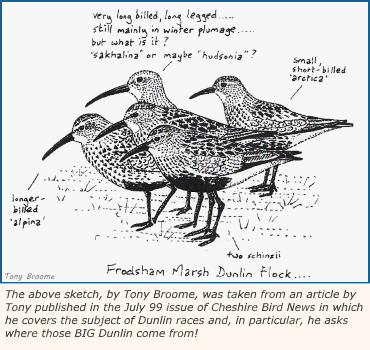
Dunlin - Rings, Races and Genes
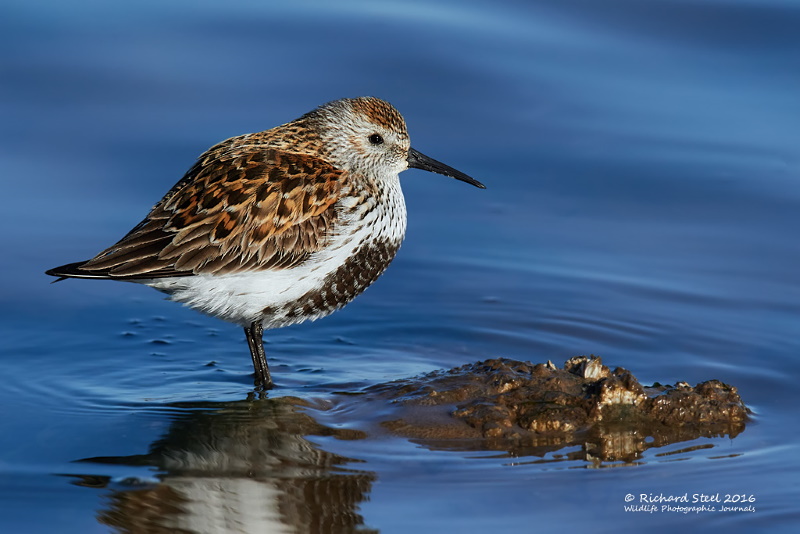
I think it's fair to say that of all our wader species the Dunlin is
the
most studied but there is still an awful lot we don't fully understand.
For
example, 10 sub-species are generally recognised yet recent genetic
studies suggest only five groups with, it could be argued, only the
Canadian Dunlin (Calidris alpina
hudsonia)
being distinctive enough to warrant the status of sub-species. At the
other extreme Wetlands International describe 13 populations when
compiling
their latest Waterbird Population Estimates - each of which, depending
on your definition of such, could be classed as a sub-species. Then
there is the problem of size, despite being genetically similar the
different types range from being little bigger than Little Stints to
ones within the size range of
Curlew Sandpipers - and that's just on Hoylake beach in late May! And
we haven't even mentioned the complexities of different breeding areas,
migration routes, moulting strategies, wintering areas........
But lets continue this article by sticking with what we know about the Dunlins that visit the Dee estuary, and ringing has told us a lot.
Ringing
The Merseyside Ringing Group have been ringing
Dunlins, and reading rings from Dunlins ringed elsewhere, for over 60
years. I've used their records as published in
the
Cheshire and Wirral Bird Reports (1970 onwards), together with more
recent Colour Ring records to produce the maps below.
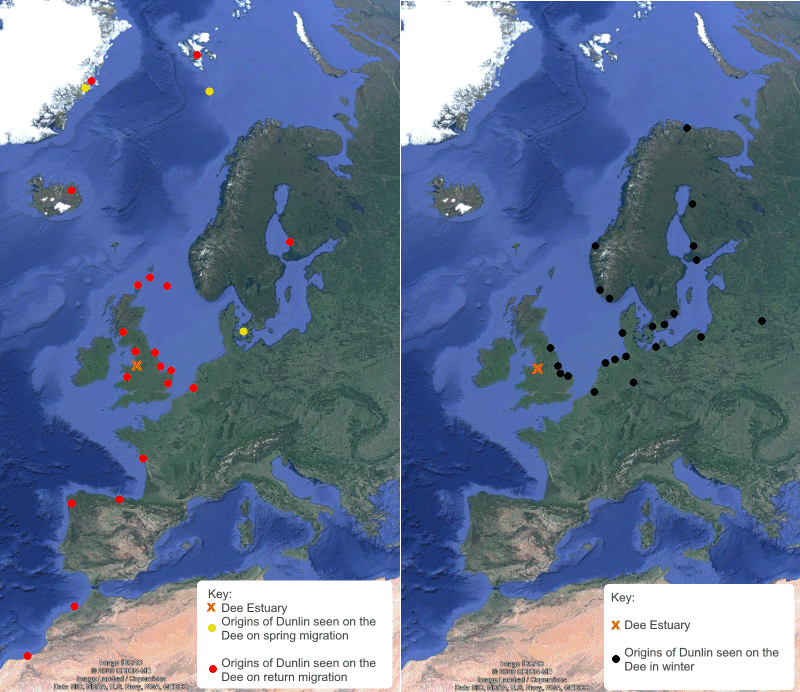
In the left hand map, Dunlin which have visited the
Dee during the
spring and return passages (mainly the months of May and August) have
been recorded in their
breeding sites of Iceland, Greenland, Svalbard and the Baltic, as well
as on passage elsewhere in the UK. These Dunlin have also been recorded
to the
south of us with the ones in France and Spain on
migration to and from their over-wintering areas in Africa. In
contrast, the
Dunlin which spend the winter on the Dee are from the race which breed
in
northern
Scandinavia and north-west Siberia. Very few are ringed in the vastness
of the tundra but over the years many thousands have been trapped and
ringed as they pour
through the Baltic and down the Norwegian coast as can be seen in the
right hand map. These two populations, the passage Dunlins and
the over-wintering Dunlins, thus seem to be completely separate.
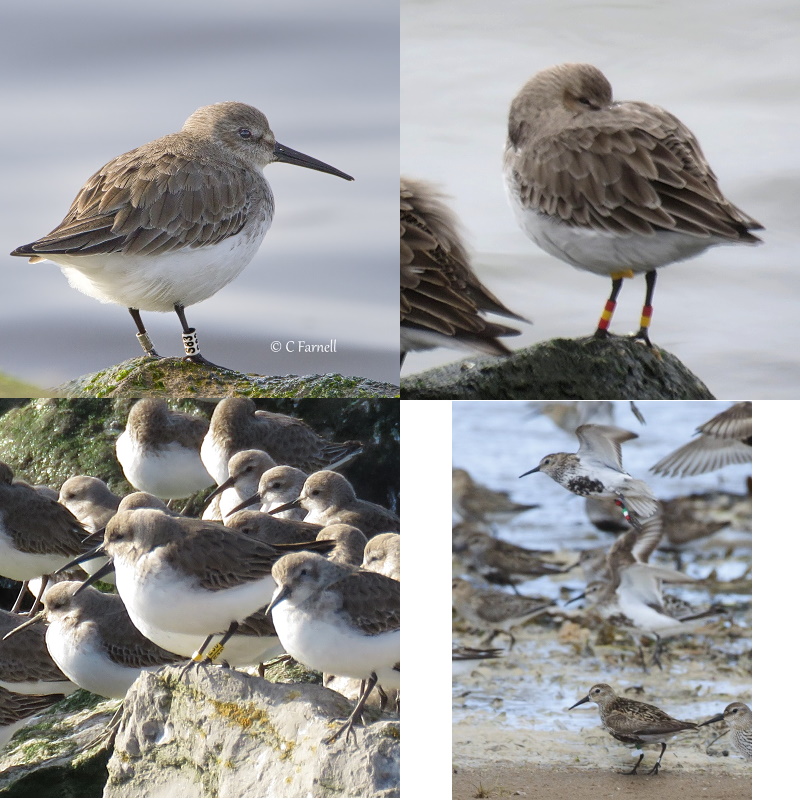
Top left: S83 ringed in Gdansk, the Polish Ringing Centre has ringed many thousands of Dunlin over the years (Charles Farnell).
Top right: Yflag/RYR-RY ringed on the eastern shore of the Waddensea (Jade Bay, Germany) (Paul Ralston).
Bottom Left: E30 ringed in Belarus (Richard Smith).
Bottom Right: Top bird - R/GWR was ringed near Vigo, north-west Spain, Bottom bird - GWflag was ringed near Bilbao, northern Spain (Matt Thomas).
The two Spanish ringed birds were recorded here in August and thus are the schinzii race, the other three were all seen here in winter and are alpina.
Over the past 70 years or so tens of thousands of
Dunlin have been ringed in Europe with thousands of these consequently
recovered. Ringing has it's limitations but it has given us a broad
outline of the movements of the main races which visit north-west
Europe and I go into details of these next.
Races
It's time to put names on these different groups of
Dunlin which visit the Dee Estuary, and I'm going to call them races
rather than subspecies (not
entirely accurate) or forms/types (a bit ambiguous). The graph below
shows
the three peaks we get through the year, particularly pronounced at
Hoylake, with the name of the Dunlin races present. Below that are more
details of each race.
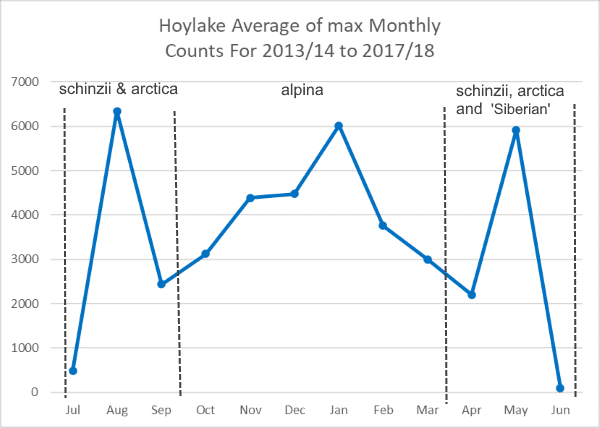
Calidris alpina
arctica - breeds in north-east Greenland, and thought to winter
mainly in West Africa with schinizii.
They pass through the UK, mainly on the west coast, in April/May and
August.
Estimated numbers have recently been upgraded from 15,000 to around
33,000.
Calidris alpina schinzii -
three populations, one breeding in Iceland, one breeding in the UK and
one breeding in southern Scandinavia and around the Baltic coast.
Probably most of the large Icelandic breeding population pass through
the UK in April/May and August on their way to and from northern and
West Africa
where they spend the winter. Some of the British and Baltic breeding
birds undoubtedly find their way to our estuaries but in much smaller
numbers than the Icelandic birds.
Iceland population is estimated to be 950,000. British population is
24,500, a small but still significant number. The Baltic population is
decreasing fast and is probably only at around 3,000.
Calidris alpina alpina -
breeds northern Scandinavia and north-west Siberia. Winters in western
Europe with the UK one of the most important areas for this race. A lot
of juveniles migrate down the coast of Norway whilst adults are more
likely to fly through the Baltic - the right hand map above shows birds
using both routes.
alpina are the most numerous
of the races with 1,330,000 individuals.
Interestingly, recent surveys have shown that they are increasing in
northern Scandinavia in contrast to the southern Scandinavian/Baltic
Dunlin which are in steep decline.
Note in the above graph are Dunlin I have called
'Siberian' which are recorded
at
Hoylake in the second half of May and I explain what these are in the
"Northern Dunlin Puzzle" below.
In addition we should mention:
Caldris alpina centralis -
breeds across northern central Siberia to the east of alpina. Ringing has shown centralis does occur on continental
Europe and thus is also likely to occur in the UK.
'Beringian Dunlin' is a
collective name for the three or four races which are found further
east than centralis including
in the Bering Strait area. In particular Dunlin which look like they
come from the C. a. sakhalina
race are sometimes recorded in the UK, although their presence here,
along with other Beringian Dunlin is not proven and is the subject of
much debate.

Genes
I said at the start of this article that genetics
suggest that there are only five groups of Dunlin in contrast to the
ten sub-species generally recognised. I quote from Parkin & Knox
describing these five groups: "These
lineages are European: arctica,
schinzii, alpina; C Siberian: 'centralis'; Beringian: sakhalina; Alaskan: arcticola,
pacifica; Canadian: hudsonia". They go on to say
research shows that Dunlins "went
through a bottleneck some 200,000 yrs BP but that since then the
populations have been larger and the major lineages have diverged
through restricted gene flow due to their fidelity to both breeding and
wintering areas". Fascinating
stuff but I think we should acknowledge that there is a lot more to
come from genetics before it tells us the whole story. For example, the
work done so far doesn't differentiate between the arctica and alpina
races when they are so obviously and consistently different in size,
beak length and summer plumage (i.e biometrics). Interestingly, the
nominate race alpina shows
up in recent genetic studies as just an intergrade between schinzii in
the west and centralis in the
east - to quote Marthinsen: "However, alpina
is an overlap zone between
the two" and "alpina
is thus not distinct from either of it's neighbouring subspecies",
rather embarrassing for the Dunlin nominate race and most numerous of
all the sub-species!
Whatever we make of all these genetic studies there is no doubt it has greatly helped in clarifying where the various populations of migrating and overwintering Dunlin breed. This work involves analysing mitochondrial DNA (mtDNA) haplotypes. A haplotype is a section of mtDNA which is inherited unchanged from a bird's mother, both males and females inherit these haplotypes but they are only passed on maternally. It just so happens that the scientists have identified in Dunlin a European haplotype, and a Siberian haplotype, and the ratio of these change as you sample birds going from the west, e.g. Greenland with 100% European haplotype, to eastern Siberia with 100% Siberian haplotype and this means we can precisely link a breeding location with a wintering area, as well as the migration routes between the two.
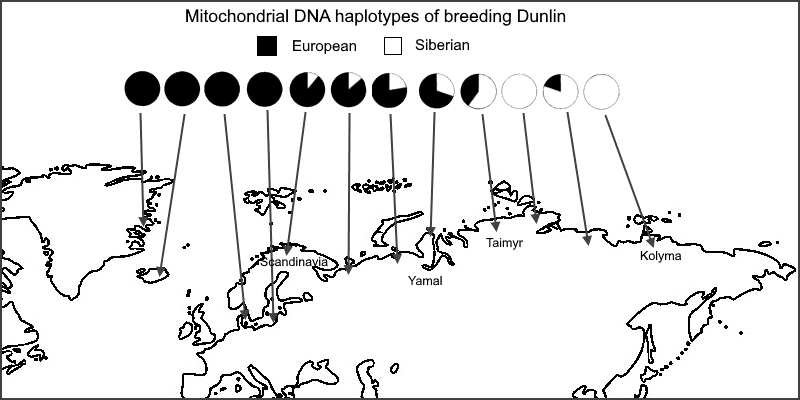
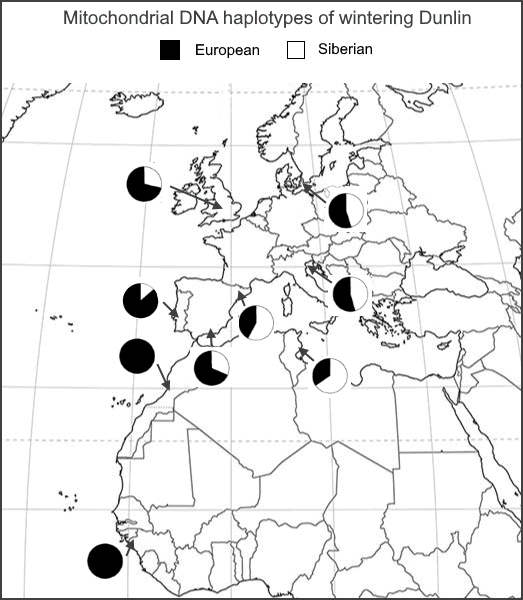
The maps are a summary of various published papers
and are shown here just to give an idea of the work being done - see References
for further details. So far a relatively small numbers of Dunlin have
been tested and I suspect that further work may well show a more
complex picture than that shown. The maps confirm that birds breeding
in Greenland (arctica),
Iceland and southern Baltic (schinzii)
winter in north-west and west Africa. Birds which winter in the UK and
elsewhere in north-west Europe (alpina)
seem to breed right across western Siberia rather than Scandinavia,
whilst the latter appear in Portugal. The
Mediterranean is interesting with quite a high percentage of Siberian
haplotypes and these appear to use two main migration routes: north via
the Waddensea and/or the Baltic, or north-east via the Black Sea, and
these would seem to be good candidates for the centralis
race. There is also a Beringian haplotype but none has yet to be found
in any sampled Dunlin in Europe, and no ringed Dunlin of the sakhalina race has ever been
recovered in Europe. And yet..............
"The Northern Dunlin Puzzle"
I came across the paper with this title whilst researching for this article - and it immediately intrigued me. Written by Hans Meltofte, the Northern Dunlin he refers to are the alpina and centralis races (or at least those of the centralis race which winter in Europe and north Africa). It was written in 1991 when there was much still unclear about Dunlin migration, hence the puzzle, but Hans did an excellent job of pulling together what was known at the time to give a brilliant summary. Much of what he wrote has since been confirmed by the genetic studies described above.
He splits wintering Northern Dunlin into three
populations - 1. UK wintering birds, 2. French wintering birds, 3.
'Siberian' breeding birds which mostly winter in the Mediterranean.
It's this third group which is of particular interest to us for reasons
described below and I quote from Hans' paper when he writes about these:
(Some) use the Wadden Sea and Danish staging areas from early to late May or early June.
Among the Siberian birds some have characters similar to the eastern subspecies C. a. sakhalina.
I read that and thought - that's Hoylake in May! So
let's recap - as the Hoylake monthly distribution graph above shows,
and Hans also says in his paper, the Dunlin which over-winter in the UK
(alpina) leave us during March
heading east to the Waddensea to moult before flying north. At Hoylake,
on the west coast of the UK, the schinzii
and arctica
race Dunlins then come through during April and May on their way from
Africa to Iceland and Greenland. With their small size, short bills and
relatively dull summer plumage these schinzii
and arctica birds are easy
enough for the experienced Dunlin watcher to distinguish from the
bigger and brighter alpina.
But then something strange happens which doesn't seem to be recognised in any paper or book I've read - from mid to late May we see the arrival of big and bright Dunlin on the beach at Hoylake looking very much like alpina, or even centralis, and I'll call them Siberian as surely that's what they must be. These aren't just a few birds but several thousands and they often outnumber the schinzii and arctica already present. Intriguingly, among these flocks we always get a few really big Dunlin looking very like they are Beringian (sakhalina race?) - just like the 'Siberian' birds mentioned by Hans Meltofte. Considering no Beringian Dunlin has ever been proven to occur in the UK this is remarkable, they are never very numerous but a search through the flocks always reveals one or two, so they are scarce but regular, not just rare vagrants. Below are some photos of these Beringian type Dunlin taken on Hoylake shore over the years by Jane Turner - as Jane says if you were on the coast of the Bering Strait you wouldn't think twice about these Dunlins being in the right place. Whether these really are Beringian or not can only be confirmed by catching some, sampling for DNA and fitting a tacking device, that would certainly be interesting! Either these Beringian looking birds breed much further west than generally recognised or they travel the huge distance from the far eastern edge of Siberia to western Europe and even west Africa. We do know that the bulk of the Beringian Dunlins winter in Japan, Korea and the Chinese coast, some 8,000 miles away from west Africa!
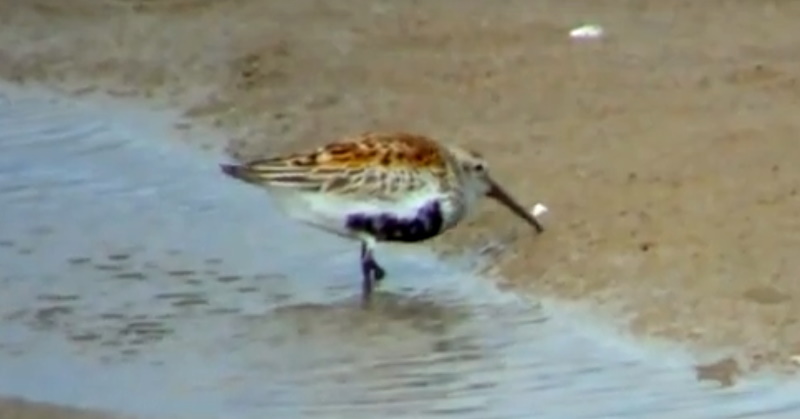


Photographs by Jane Turner.
Presumably these Siberian Dunlin must be from the
same
population, described by Hans Meltofte in the quotes above, as
migrating late, using the Waddensea as a staging post in late May and
containing birds
looking like sakhalina/
Beringian. From the maps it
would seem likely that these winter in the western
Mediterranean. But traveling north-east from Spain to reach the
Waddensea is one thing, flying north-west to the western coast of the
UK before flying sharply north-east to Siberia doesn't make any sense
to me. There is a noticeable passage of waders through Hoylake in late
May - mainly Sanderling, Ringed Plover as well as the schinzii and artica Dunlin, and all are moving
up from West Africa (or further south) and making their way to
Greenland, Canada or Siberia. Why should these Siberian Dunlin be any
different, i.e. that they have also spent the winter in West Africa?
There is no evidence for this but there is very little detailed data
about any
of the Dunlin races which winter in West Africa, and it is certainly
possible that a few thousand Siberian Dunlin could be hidden among the
large number of Icelandic schinzii
birds present. One thing is for certain is that the wintering area of
these Siberian Dunlin which we see at Hoylake remains unknown, and we
know virtually nothing about what these big and bright Beringian type
Dunlin really are. So the Northern Dunlin remains a puzzle!
as well as known route of schinzii and arctica
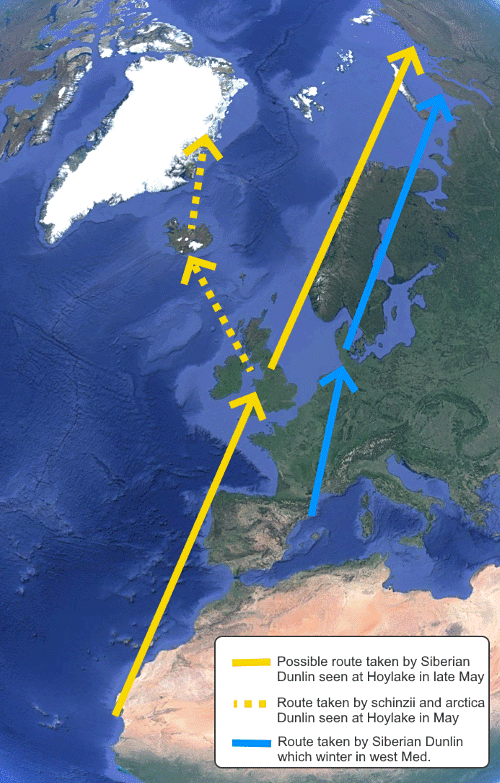
Acknowledgments
Many thanks to Jane Turner for her help, this
article wouldn't have been written without her acute observations of
the 'Siberian' Dunlins on Hoylake shore in May and their attendant
Beringian looking birds. She pointed me towards many fascinating papers
published in various journals, many of which I've referenced below, and
kindly sent me many photographs.
Also many thanks to the Merseyside Ringing Group whose hard work over
many years has resulted in a mass of ringing data for Dunlin which have
passed through the Dee Estuary and North Wirral coast.
This article is therefore just my amateurish attempt at summarising all
this work, obviously any mistakes are my own, and any conclusions and
speculations are also my own. But I've thoroughly enjoyed writing it!
References and Sources of Information
1. Tony Broome, Dunlins, Dunlins and More Dunlins, CAWOS Bird News 43, July 1999.
2. Ringing Reports published in the Cheshire/Cheshire and Wirral Bird Reports 1970 to 2018.
3. Dunlin records for Hoylake provided by CAWOS.
4. Various records, information and comments provided by Jane Turner - October and November 2020, pers. comm.
5. Simon Delany et. al, An Atlas of Wader Populations, Wetlands International, 2009.
6. Waterbird Population Estimates, Fifth Edition, 2012.
7. Parkin and Knox, The Status of Birds in Britain and Ireland, Helm, 2009.
8. R.J. Lopes et. al, Migratory connectivity and temporal segregation of dunlin ( Calidris alpina ) in Portugal, Journal of Ornithology, (2006) 147.
9. G. Marthinsen et.al, Phylogeography and subspecies taxonomy of dunlins (Calidris alpina) in western Palearctic analysed by DNA microsatellites, Biological Journal of the Linnean Society, (2007), 92.
10. L. Wennerberg, Breeding origin and migration pattern of dunlin (Calidris alpina) revealed by mitochondrial DNA analysis, Molecular Ecology (2001), 10.
11. R.J. Lopes et. al, Geographical segregation in Dunlin Calidris alpina populations wintering along the East Atlantic migratory flyway – evidence from mitochondrial DNA analysis, Diversity and Distributions (2008), 14.
12. Hans Meltofte, The Northern Dunlin Puzzle, Wader Study Group Bull., (1991), 62.
Richard Smith.
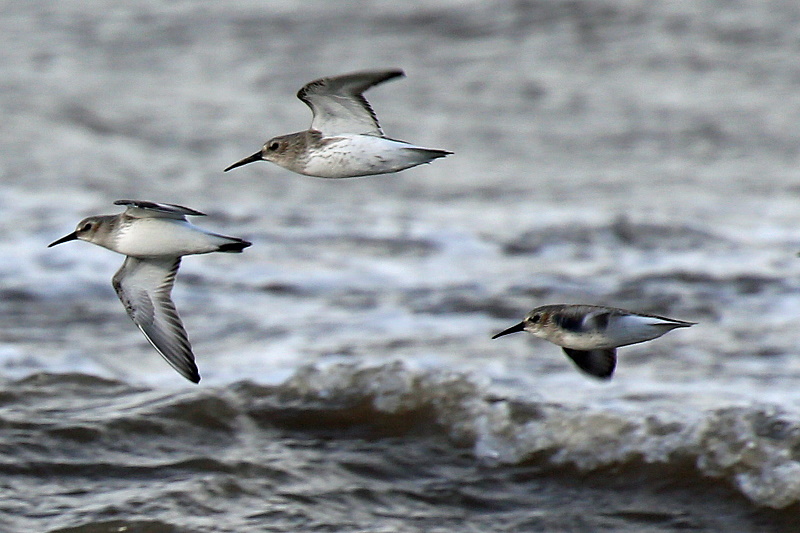
Top of Page
Colour Ring Report
Dunlin

5PL on white ring
Ringed in Gdansk, Poland, 08/08/2016.
Recorded:
Leasowe Bay on 29/12/2016.
West Kirby Marine Lake on 13/11/2020.
Meols groyne on 19/11/2020.
Grey Plovers
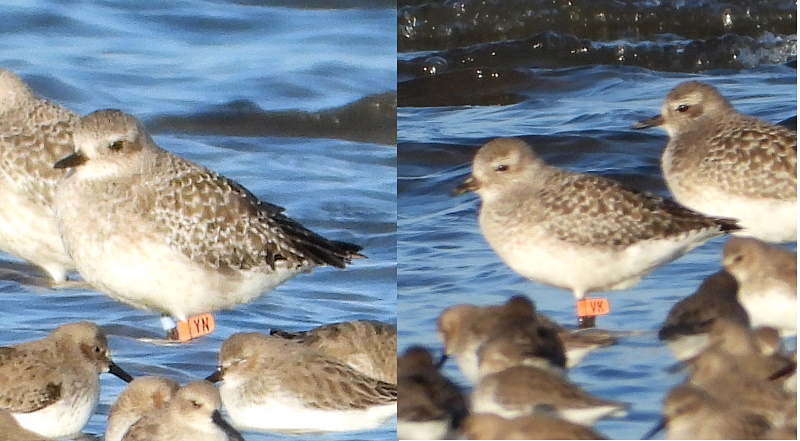
There was something of a colour ringed Grey Plover bonanza at Hoylake
mid-month, with ten records between 13th and 15th November. Here is a
summary of the histories of the two in the photographs:
Both birds were ringed just north of the Alt Estuary
on 30/3/2018. They seem very site faithful and they have both been seen
at Hoylake before, together on the same date - 12/10/2018. All other
records
have been from the Sefton coast between Southport and Formby. There are
no records between mid-November and mid-February indicating that they
move on in mid-winter. Other birds from this scheme have been recorded
in Brittany so perhaps they go there but many Grey Plovers migrate all
the way to West Africa.
Knots
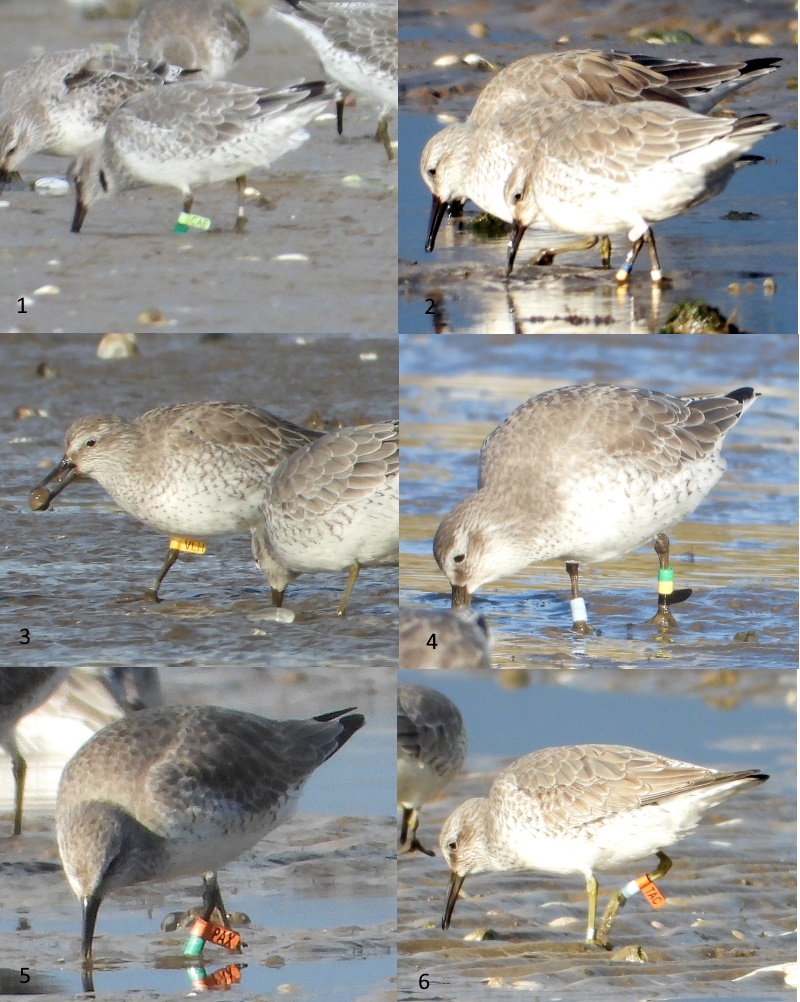
We estimated there were at least 40,000 Knot in the Dee estuary
in
November, and we had a lovely time reading colour rings/flags. In total
there were 306 records with the large majority being ringed locally
just north of the Alt estuary. But we saw plenty from elsewhere as
well and here are the details of the six birds in the montage above:
1. CAE on a Lime
flag, over Green ring.
Ringed at Terrington on the Wash on 23/08/2020.
Recorded at Thurstaston on 24/11/20.
This is a new scheme run by the Wash Wader Ringing Group, so far they
have ringed 133 Knot but knowing how keen this group is I'm sure they
will be ringing plenty more. CAE is only the fourth of these L flagged
birds to be seen since ringing, the others being on the Wash,
Heysham and Findhorn Bay.
2. W1_WBY.
This Knot is missing a ring which should be on the left tarsus
but from the White flag and the other three rings we know that it was
ringed in northern Canada at Alert, Ellesmere Island, either in 2007 or
2008.
Recorded at Thurstaston shore on 4/11/2019, at Meols on 2/02/20 and
again at Thurstaston on 26/11/2020.
3. Yflag VLH.
Ringed on passage in NW Iceland on 22/05/2014, where it was seen again
in May 2015 and May 2018.
Also recorded:
Dutch Waddensea From Jul to Oct 2016 and again in Aug and Oct 2017.
It was at Formby in Oct 2016 and at Thurstaston in Feb 2018, Oct and
Dec
2018 and Nov 2019.
In 2020 it was at Crosby in Jan and at Thurstaston on 25/11/2020.
4. N7GYPP
Ringed on the lonely island of Griend in the Dutch Waddensea on
26/08/2017.
Recorded:
It remained near Griend until Oct 2017 when it then moved to
Thurstaston and seen in Dec 2017 and Jan 2018, it was at West Kirby
when the 'beast from the east' struck in early Mar 2018.
It was back at Griend in the autumn of 2018 before again moving to
Thurtaston in Dec 2018 and West Kirby in Jan 2019.
Seen again at Thurstaston on 2/11/2020.
5. Oflag PAX over
Green ring.
Ringed in Bangor Harbour (North Wales) on 24/01/2020.
Recorded at Thurstaston on 26/11/2020.
6. Oflag TAC over
Pale blue ring.
Ringed at Ynyslas NNR in Cardigan Bay on 1/09/2020.
Recorded at Thurstaston on 25th and 26th Nov 2020.
Sanderlings
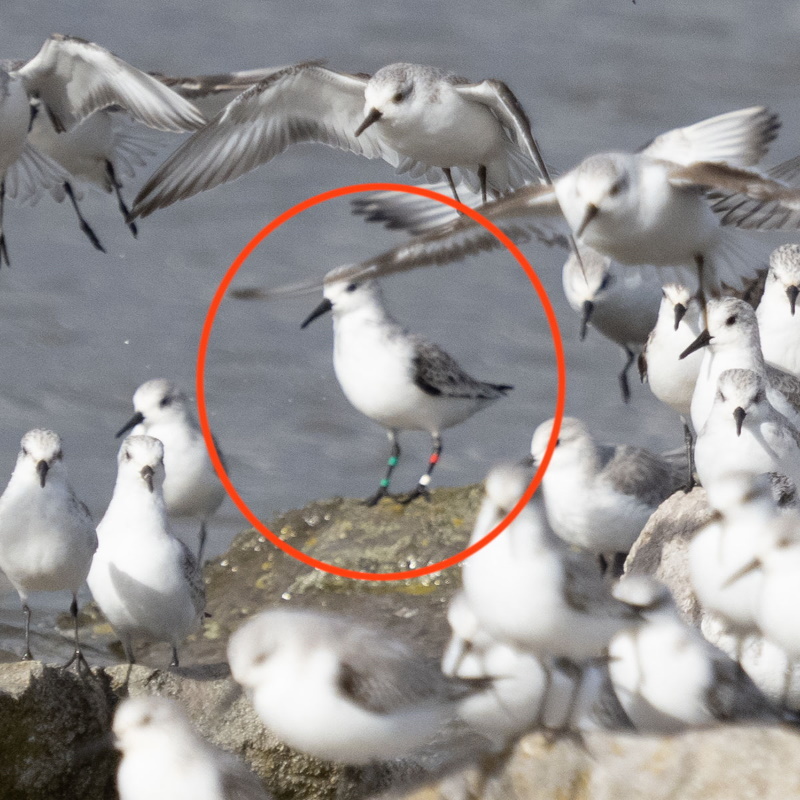
G6RWGG
Ringed in NE Greenland on 28/07/2011.
Recorded:
Hoylake on several dates from Jan to March 2013, in Jan and Nov 2014
and Jan 2015.
Formby in Sep 2014, Apr 2015, Sep 2016 then on nine dates in 2017.
It was on Meols Groyne on 20/10/2020 and missing it's green flag, but
ringer confirmed ID.
G5WGGW
Ringed in E Greenland (at Ostgronland) on 05/07/2008.
Recorded:
Cadiz, Spain, in 2010 in Feb and Dec, and in Mar 2011.
Ostrogonland (Greenland) in Jun 2010 and Jun 2011.
Ainsdale (Southport) on 28/04/2017.
Hoylake on 14/11/2020.
Interesting that both these Sanderling were last seen on the Sefton coast in 2017, before turning up on North Wirral this autumn.
Shelduck
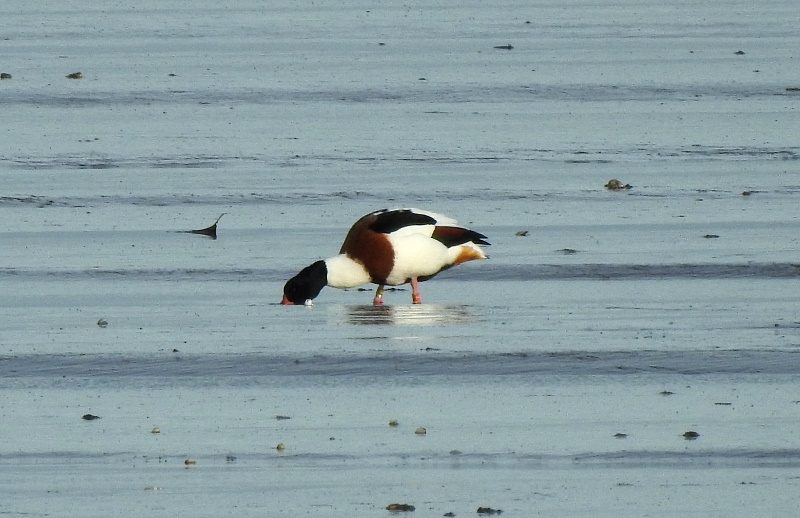
C on red ring/H on yellow ring.
Ringed at North Duffield Carrs, Lower Derwent Valley NNR, Yorks, on
18/05/2018.
Recorded at Meols on 12/11/2020.
We've now seen several of these Lower Derwent Valley Shelduck, interesting that they travel this far to spend the winter. I wonder where they moult?
Colour-rings were recorded by Richard Smith, Steve
Hinde, Matt Thomas, Tim Kinch, Colin
Schofield, David Leeming, Elliot Montieth and Charles Farnell.
November Bird News
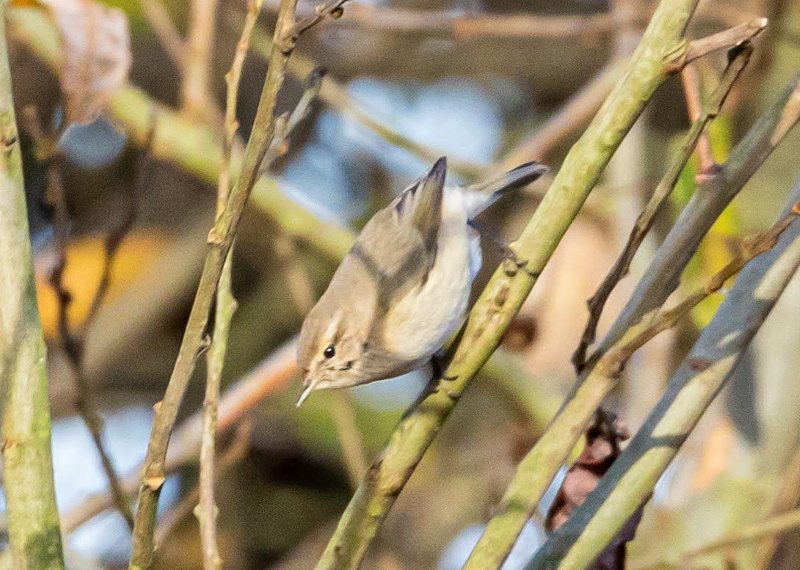
There were some interesting smaller birds this month including
Yellow-browed Warbler (10th and 11th), Siberian Chiffchaff (13th to
19th) and a Snow Bunting (various dates) all in the Meols and Leasowe
area. Also two more Snow Buntings at Point of Ayr and a Lapland Bunting
in Red Rocks Marsh.
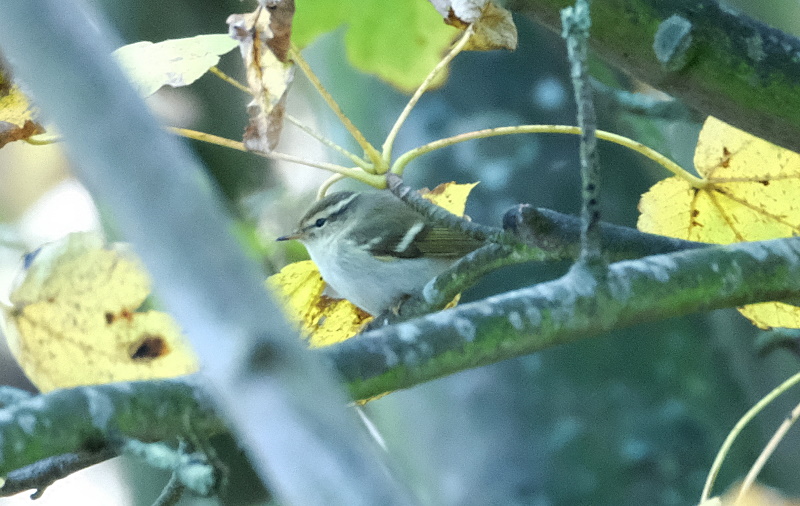
Numbers of Cattle Egrets continue to increase at Burton and Puddington
with at least 15, and maybe even 20! Great Egrets are also in good
numbers and we now see them everywhere with a max of 32 coming in
to roost at Burton Mere Wetlands on the 17th. How many years before
they reach 100?? There's been at least five Hen Harriers on the marshes
(2 adult males, 1 sub-adult male and 2 ringtails) and the max count of
Marsh Harriers was 10. It was good to see four Short-eared Owls off
Gayton during the very high tide on the 15th. A Bittern was spotted
coming
in to the roost at Neston Reed Bed several times.
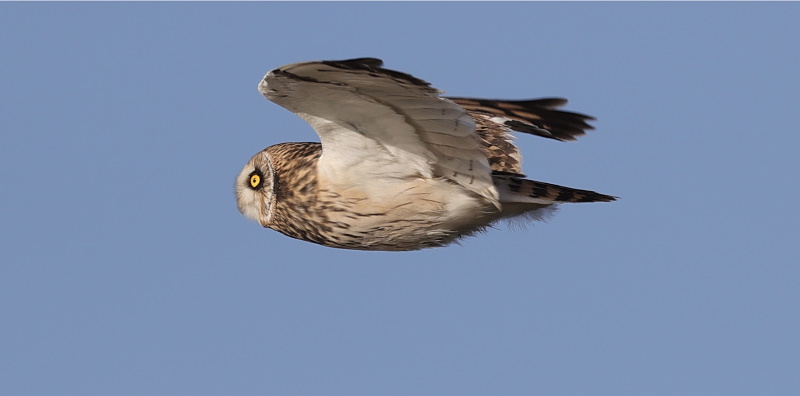
Wader numbers have been good with at least 40,000
Knot on the estuary and 800 Sanderling at Hilbre and Hoylake was a good
number whilst the largest flock of Dunlin counted was 7,500 both off
the south end of West Kirby Marine Lake and at Hilbre. Ten Purple
Sandpipers were counted at Hilbre with a further eight at New Brighton
Marine Lake. Goosanders have returned to West Kirby Marine Lake with 13
the highest count so far this winter.

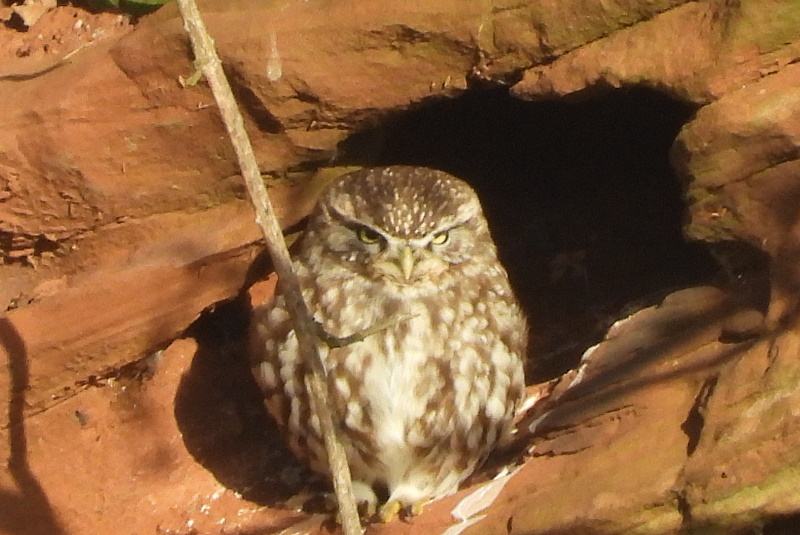
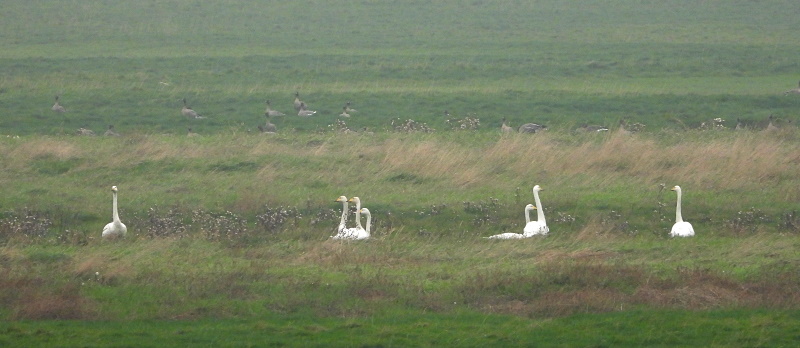
What to expect in December
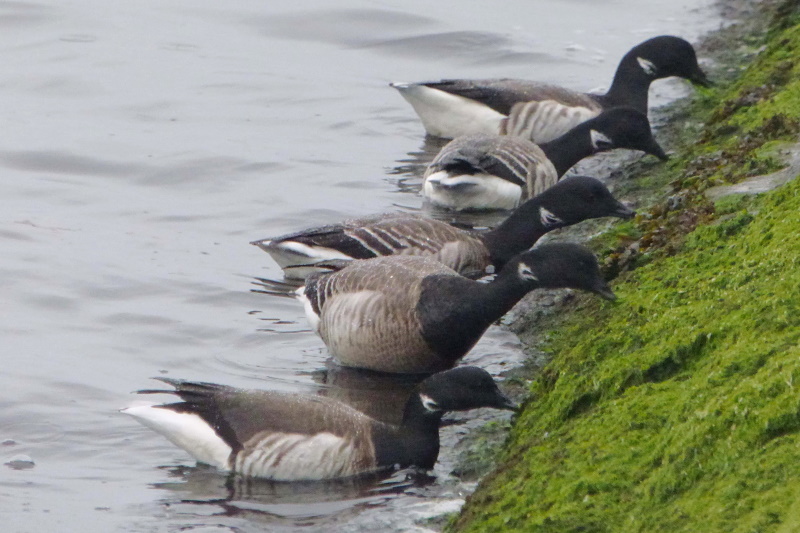
After a very mild November it would be good to get some nice crisp cold
days, specially over the Christmas period. It's always a joy to be on
the shores of the estuary in such weather watching large flocks of
waders, particularly Knot, putting on spectacular displays. Knot
numbers are currently high with around 40,000 with good numbers of
Oystercatchers, Sanderling and Dunlin as well.
West Kirby Marine Lake is worth checking out with a small flock of Goosanders, around ten, now regular with also a few Red-breasted Mergansers and Goldeneye, and there's always a possibility of a Red-throated or Great Northern Diver. In recent years Brent Geese have been flying on to the lake feeding on seaweed on the lake wall so you can get really close to these lovely birds which breed on the Canadian tundra. Our other Marine Lake, at New Brighton, is always worth checking at high tide for roosting waders and we should get Purple Sandpipers there in double figures.
A visit to Parkgate or Neston in late afternoon is always worthwhile with Short-eared Owls hunting, and both Marsh and Hen Harrier flying in to roost. The last two winters have brought good views of one or two Bitterns there.
Water Pipits can be seen in the damp fields between
Neston Old Quay and the sewage works as well as at Burton Mere
Wetlands. A few Snow Buntings are usually on our coasts with Point of
Ayr
is probably the best spot but also Hilbre and anywhere along the north
Wirral coast. Twites are rare on the English side of the estuary but
are regular at Connah's Quay and Flint.
Forthcoming Events
December Highest Spring Tides (Liverpool)
Also see Tides page.
15th December, 11.11hrs (GMT), 9.7m.
16th November, 11.57hrs (GMT), 9.7m.